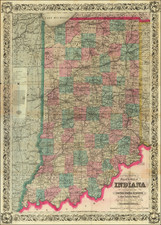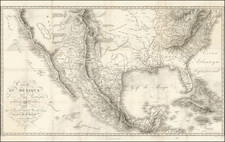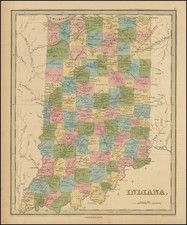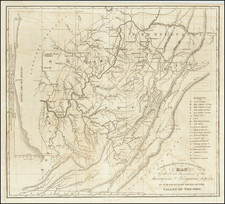Extends Into Six States Without Change of Cars Through Union Depot -- Avoiding Ferry Transfers and Delays
Scarce route map and time table for the Lake Shore and Michigan Southern Railway, published on March 26, 1882.
The map extends from New England and the Mid-Atlantic States to the Mississippi River, highlighting the routes from Chicago to Grand Rapids, Lansing, Detroit, Buffalo, Oil City and Youngston Ohio.
Lake Shore & Michigan Southern Railway
The Lake Shore and Michigan Southern Railway has its origins rooted in several smaller lines that would eventually consolidate to form the railway known for connecting Buffalo to Chicago. The journey to its formation began with the chartering of the Franklin Canal Company on May 21, 1844, which established a railroad from Erie, Pennsylvania, to the Ohio border. Subsequently, the Cleveland, Painesville and Ashtabula Railroad came into being on February 18, 1848, designed to connect with the Canal Company's line at the Ohio state line, completing the link from Erie to Cleveland by November 20, 1852.
The railroad's reach expanded with the establishment of the Buffalo and State Line Railroad on October 13, 1849, which commenced operations from Dunkirk, New York, to Pennsylvania on January 1, 1852, and subsequently extended to Buffalo. Meanwhile, the Erie and North East Railroad was chartered on April 12, 1842, opening its route on January 19, 1852. A significant development came when these two railroads, which were initially built at a broad gauge, agreed on November 16, 1853, to change their rails to the standard gauge, a decision that prompted the Erie Gauge War but eventually allowed for uninterrupted travel through Erie after February 1, 1854.
The railway narrative continued with the Junction Railroad, chartered on March 2, 1846, connecting Cleveland to Toledo, and the Toledo, Norwalk and Cleveland Railroad, chartered on March 7, 1850, further completing the Buffalo-Chicago line. These two merged on September 1, 1853, to form the Cleveland and Toledo Railroad.
The consolidation efforts culminated when the Cleveland, Painesville & Ashtabula Railroad, which renamed itself the Lake Shore Railway on March 31, 1868, absorbed the Cleveland & Toledo Railroad on February 11, 1869. A few months later, on April 6, 1869, it merged with the Michigan Southern & Northern Indiana Railroad and then the Buffalo & Erie Railroad on June 22, 1869, giving birth to the Lake Shore & Michigan Southern Railway. This railway spanned across significant cities such as Dunkirk, Erie, Ashtabula, Cleveland, Toledo, Waterloo, Indiana, and South Bend, with alternate routes and branches serving other vital areas in Ohio, Indiana, and Michigan.
By the 1870s, Cornelius Vanderbilt and his New York Central and Hudson River Railroad gained a controlling interest in the Lake Shore & Michigan Southern Railway, setting the stage for its eventual integration into the New York Central Railroad on December 22, 1914. The line would go through further transformations, becoming part of Penn Central in 1968 and subsequently Conrail in 1976, before being divided between CSX and Norfolk Southern in 1998. The track remains a crucial transportation corridor, with Amtrak's Lake Shore Limited service running along this historic route.
In Michigan, the Lake Shore & Michigan Southern Railway operated major terminal operations in cities like Adrian and Hillsdale and had branch lines extending to burgeoning urban centers such as Jackson, Lansing, Ypsilanti, Kalamazoo, and Grand Rapids. It was a critical part of the region's development, facilitating the transport of people and goods and contributing to Michigan's growth.
Rarity
Lake Shore & Michigan Southern Railway maps began appearing as early as 1871 but are generally quite scarce.
OCLC lists only 2 examples of such maps published between 1878 and 1899:
- 1881 edition: Stanford University, Rumsey Map Library
- 1883 edition: University of Michigan, Clements Library
The Huntington Library also holds an example dated April 1884.











![Cincinnati and Environs [with] Business Portion of Cincinnati on Enlarged Scale](https://storage.googleapis.com/raremaps/img/small/84841.jpg)




